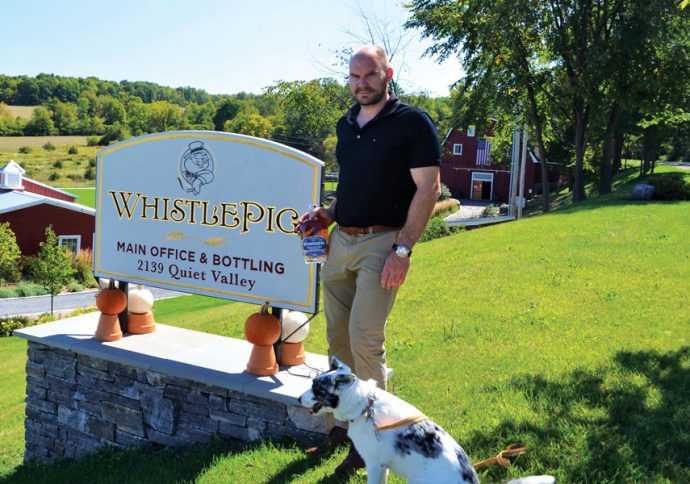Whiskey drinkers are a loyal group. Wine drinkers might drink a Cabernet one night, a Sangiovese the next and a Chardonnay the third. But a whiskey drinker knows what he or she likes and tends to stick with it. There are the Irish whiskey drinkers, there are the bourbon whiskey drinkers and there are the Scotch whiskey drinkers. And Scotch drinkers either move toward pure highland flavors or the more peaty and smoky lowland tastes. Well, here’s a class of whiskey that your great grandparents might have enjoyed but then was crushed by Prohibition, fell out of favor and never properly recovered — until now.
Sales of rye whiskey have been on a massive upward trend. Since 2009, American rye sales have increased from 88,000 cases to 775,000 cases (in 2016), an increase of 778 percent. And sales have grown in that same time period from $15 million to $160 million. As if guided by the rye gurus of yesteryear, WhistlePig Farmstock Rye Whiskey came to be in 2009; the brainchild of Raj Bhakta. He wanted to capitalize on two big trends — rye whiskey consumption and the farm-to-table movement. Searching for an appropriate and beautiful location, Bhakta decided Shoreham, Vermont, not far from Lake Champlain, would be perfect. He purchased a 500-acre dairy farm and quickly converted it to whiskey production. He bought some aged rye whiskeys from Canada, began some blending, bottling and labeling, and he was in business.
I was in Vermont recently, gave WhistlePig a call and set up a meeting with CEO Jeff Kozak for a tour and tasting at the farm, which are not available to the public. A tasting room in Middlebury, however, and another in Waterbury, near Stowe, will give the curious and the sophisticated a wonderful experience. WhistlePig Farm is rustic yet elegant in its repurposing from milk to rye whiskey production. A Canadian, Kozak was a commodities broker, hooking up buyers and sellers of large quantities of products, like soybeans, milk or pork bellies. Bhakti called Kozak and structured a deal for delivery of many tons of rye from Canada. He then hired Dave Pickerell, with 14 years at Maker’s Mark Bourbon house in Kentucky as master distiller, and Peter Lynch as master blender.
So they went to work and test marketed their rye whiskey in the New York marketplace where it was well-received WhistlePig now has 300 acres dedicated to growing rye, making it one of Vermont’s biggest grain producers. WhistlePig employs 60 people nationwide with 25 working in various operations on location at the farm. And WhistlePig continues to expand at 40 to 50 percent per year, with sales in the $35 million range per year.
By the way, “whistlepig” is a word Bhakti heard someone say on a hike in the hills one day. A whistlepig is a marmot, a black and mountain dwelling woodchuck, which gives a clear and distinct whistle when it needs to communicate. Bhakti thought to himself, “One day I will use that name, for something.”
Kozak told me, “We are not corporate owned. We are not part of a distilling empire. Our team makes all our fermentation, distillation, blending and aging decisions, in house, on location. And we are confident rye is the new cool kid on the block.”
Several of Whistlepig whiskeys are aged and finished from white oak wood harvested from the property. Some of the other whiskeys are blends of products aged in used Port, Sauternes and Madeira barrels. Each of these barrels will contribute an accent to the final flavor. Kozak asked me if I ever find an interesting used barrel flavor in my travels to let them know, please. He and his team are always looking for exciting new concepts. WhistlePig rye whiskies have won several national competitions and have received top praise from national spirits magazines.
My first impressions of the tasting were of relief. I was expecting flavors of bakery rye bread, of which I’m not a big fan. The flavors were pure and wonderful whiskey flavors. The alcohol levels in all of them were well-integrated and not hot, astringent or biting. The oak influence and then the wine and/or fortified wine-impregnated wood gave unique flavors to each bottle. But throughout the line in varying degrees I found caramel, some dark chocolate, vanilla and hints of dark and dense coffee, held together by a backbone of sweet white oak. This is a brilliant mixer that would do justice to any cocktail calling for whiskey. But I would taste it in a nice round glass with a small cube and drink it as a pre-dinner experience or for dessert. This is a savoring whiskey. Swirl, smell, swirl and smell again. And taste. Thank you, Whistlepig , for purity and velvety smoothness in the glass.
For more, visit whistlepigwhiskey.com. And write me at doug@dougpaulding.com.


